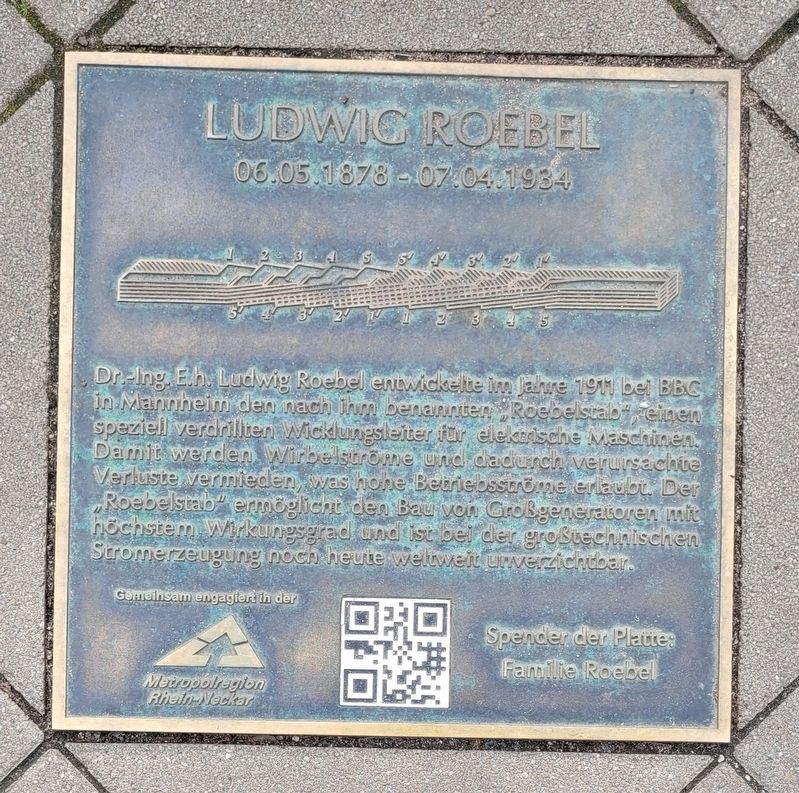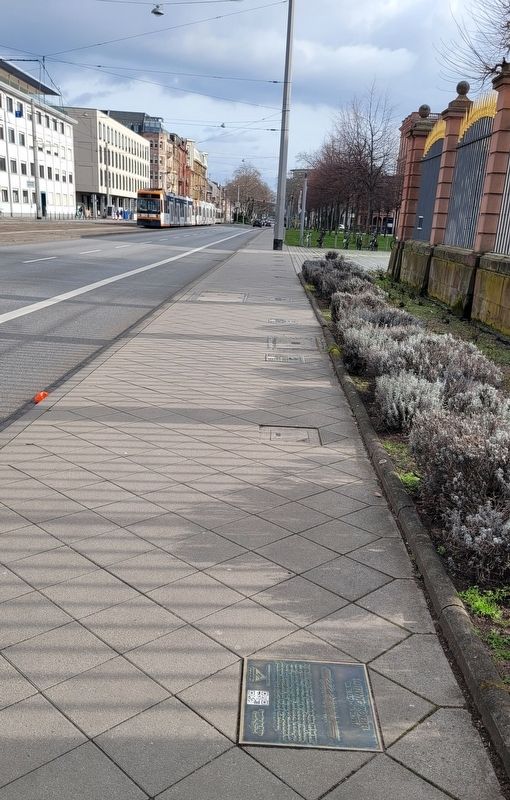Quadrate in Mannheim, Baden-Württemberg, Germany — Central Europe
Ludwig Roebel
06.05.1878-07.04.1934
Dr.-Ing. E.h. Ludwig Roebel entwickelte im Jahre 1911 bei BBC in Mannheim den nach ihm benannten „Roebelstab", einen speziell verdrillten Wicklungsleiter für elektrische Maschinen. Damit werden Wirbelströme und dadurch verursachte Verluste vermieden, was hohe Betriebsströme erlaubt. Der „Roebelstab" ermöglicht den Bau von Großgeneratoren mit höchstem Wirkungsgrad und ist bei der großtechnischen Stromerzeugung noch heute weltweit unverzichtbar.
In 1911, Dr.-Ing. E.h. Ludwig Roebel developed the “Roebelstab” named after him at the BBC in Mannheim, a specially twisted winding conductor for electrical machines. This avoids eddy currents and the resulting losses, which allows high operating currents. The “Roebelstab” enables the construction of large generators highest efficiency and is still indispensable worldwide today in large-scale electricity generation.
Erected 2018 by Metropolregion Rhein-Neckar and Familie Roebel.
Topics. This historical marker is listed in this topic list: Science & Medicine. A significant historical year for this entry is 1911.
Location. 49° 29.049′ N, 8° 27.801′ E. Marker is in Mannheim, Baden-Württemberg. It is in Quadrate. Marker is on Bismarckstraße just east of Kurpfalzstraße, on the right when traveling east. The marker is located along the sidewalk in front of the University of Mannheim. Touch for map. Marker is at or near this postal address: B37 20-40, Mannheim BW 68161, Germany. Touch for directions.
Other nearby markers. At least 8 other markers are within walking distance of this marker. Luftschiff Schütte-Lanz (here, next to this marker); Prosper L'Orange (here, next to this marker); Nobelpreis Chemie / Nobel Prize in Chemistry (here, next to this marker); Nobelpreis für Medizin / Nobel Prize for Medicine (a few steps from this marker); Bulldog (a few steps from this marker); Hugo Stotz (a few steps from this marker); Julius Hatry (a few steps from this marker); Prof. Dr.-Ing. Karl Friedrich Marguerre (within shouting distance of this marker). Touch for a list and map of all markers in Mannheim.
More about this marker. The bronze plaque is one of 42 plaques set up along the “Electoral Palatinate Mile of Innovations” in front of Mannheim Palace.
Also see . . . Ludwig Roebel (1878-1934). Kurpfälzer Mile of Innovations
A small experiment at Technorama in Winterthur illustrates the effect of eddy currents. There, seven rods made of different materials have been arranged vertically.(Submitted on February 23, 2024, by James Hulse of Medina, Texas.)If the magnetic rings surrounding them are allowed to fall, it is found that the rings fall at different speeds. The magnetic field of the rings penetrates the material of the rods, sets free electrons in motion there and generates eddy currents. If the rod is a good conductor, such as a copper rod, there are strong eddy currents and a correspondingly powerful braking effect. If the rod is made of electrically non-conductive material, no braking effect is observed.
This connection between magnetic fields and electric currents was first recognized by the physicist Heinrich Emil Lenz and described as early as 1833, known as "Lenz's rule". This is how an eddy current brake, also known as an induction brake, works. It can even slow down an ICE railcar, a roller coaster or the Freefall Tower. This shows the enormous forces involved.
Credits. This page was last revised on February 23, 2024. It was originally submitted on February 23, 2024, by James Hulse of Medina, Texas. This page has been viewed 33 times since then. Photos: 1, 2. submitted on February 23, 2024, by James Hulse of Medina, Texas.

